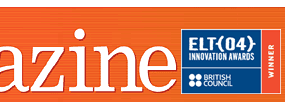|

FROM THE EDITOR
 In this Issue In this Issue
 Contributors Contributors
 Letters to the Editor Letters to the Editor
 Write to Us Write to Us
 Spread the Word Spread the Word
 Back Issues Back Issues
 Index Index
FEATURE
 Issues in Business Issues in Business
English teaching
Classroom management
for Business English
 Birthday Greetings Birthday Greetings
MED Magazine celebrates
its second birthday
COLUMNS
 Language Interference Language Interference
Borrowing and false friends
between Greek and English
 Focus on Language Focus on Language
Study:
Introduction
Word Formation
Word families,
prefixes and suffixes
UK version ¦ US version
 New word of the month New word of the month
New words in journalism
and the media
 Top Tips for Business English Top Tips for Business English
Teaching presentation skills:
Presentation Essentials 1
Activities ¦ Teacher's notes
 onestopenglish.com onestopenglish.com
|
 |
Top
Tips for Business English
by Rosemary
Richey
Teacher's notes
> Main article
> Activities
To build vocabulary related to organising and setting up a presentation.
The activities are aimed at students at upper intermediate to advanced levels. They are appropriate for one-to-one or group lessons.
Allow about 60 minutes for the activities. The time you’ll need will depend on the size of your class, and if it’s set up as pair or group work, or as a one-to-one practice. Students need copies of the Macmillan English Dictionary (MED). Teachers will need at least a flipchart or whiteboard, and ideally an OHP/OHTs.
 Activities 1 and 2
Activities 1 and 2
| Preview the topic of presentations with a 10 minute discussion. For more about this, see the top tips article in this issue. |
| Go over the introduction with the students, and then ask them to read the presentation overview individually. |
| Organise students in pairs or groups and ask them to do activity 2 using the Macmillan English Dictionary. |
| Check the answers by each pair or group contributing their findings, and display the possible answers on the OHP or give as handouts. |
Example answers
| to intend or hope to achieve something |
| to make someone agree to do something by giving them
reasons why they should |
| chances of success |
| the public image of an organization |
| the process of attracting people’s attention
to a product or service |
| a large meeting where people who are interested in
a particular subject come together to discuss ideas |
| possible |
| relating to large companies, or to a particular large
company |
| the place where an activity or event happens |
| something such as a room or piece of equipment that
is provided at a place for people to use |
| happening during the night |
| an amount of money that is paid or charged |
| advantages |
| to organize |
| to give |
| to carefully consider in order to make a judgment |
| to use |
| to express something in a definite or formal way |
| to give particular importance or attention to something |
| a short account of the most important facts or features |
 Activity 3
Activity 3
| Students do the activity in pairs and each student compares answers with a partner. |
| To check the answers with the whole class, elicit word forms for the sentences. Write these up on the whiteboard or flipchart and underline the correct answer for each sentence. |
Answers
| assessing |
aimed/was aiming |
persuade |
stated |
| emphasized |
utilize |
summary |
|
| For activity 1 elicit business sectors that rely
on presentations as an important business tool. Hotels are mentioned
as one area with promotion as its presentation objective. Have students
think of 2–3 example sectors and explain the purpose of a presentation
for each business. |
| Start a discussion on tips for organising and practising
a presentation. First, give students a few tips yourself such as:
Do they use index cards for notes? Do they practise in front of a
mirror, or with a family member, friend or colleague? Then ask them
to form pairs and come up with more tips from their own experience. |
| Depending on your class time, have students look
at the nouns profile and conference in MED. Discuss
the meanings and examples of raise someone’s profile,
a high profile and maintain/adopt a high profile.
Elicit uses of conference on, in conference and
conference call. |
| Based on activities 1 and 3 have students in pairs
share their experience in giving presentations. Discuss with them
which parts of a presentation they are more comfortable with for delivery
and why. |
| Check the answers to the activities yourself in MED with both the CD and the dictionary. |
| Practise with as many realistic examples from the students’ experience as necessary for them to understand the language used in the context of presentations. |
|





